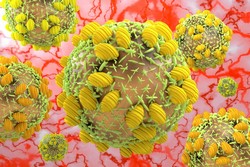Viral escape mechanisms
Viruses are known to hijack host machinery to support their replication and invasion into new cells. Virtually all viruses have evolved mechanisms to blunt host immune responses. Autophagy is a cellular process of degrading damaged organelles and protein aggregates via sequestration in vesicles. Although infected cells deploy autophagy as an immune response to fight viral infection, HCV seems to use autophagy proteins for the translation of incoming viral genomes in newly infected cells. Similarly, dengue virus uses autophagy for its own benefit, further indicating that autophagy functions as a key regulator of viral propagation. The scope of the EU-funded HEPATG (Autophagy and virulence of Hepatitis C virus) project was to elucidate the mechanisms by which HCV and dengue virus evade immune responses. By focusing on the functional relationship with autophagy, researchers discovered an alternative sensing pathway of infected cells by the host immune system. Their observations indicated that plasmacytoid dendritic cells (pDCs) come into physical cell-cell contact with the virally infected cells. Also, the activating signal is transmitted through a structural platform that consists of the actin network. Interestingly, scientists discovered that viral RNA was transferred from infected cells to pDCs through non-canonical vesicles or exosomes. This led to an anti-viral response characterised by interferon (IFN) production and demonstrated the anti-viral capacity of pDCs, which are also non-permissive to most viral infections. Collectively, the HEPATG work underscored the importance of cell-cell contact in the activation of pDCs and identified their role in anti-viral response. In addition, it validates the hypothesis that infected cells also transmit signals to regulate innate immunity such as non-infectious viral particles or host-derived products. Overall, it is anticipated that the study results will serve as a conceptual framework for similar analysis in other viruses.







